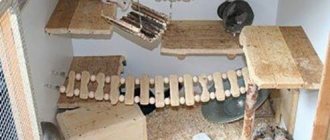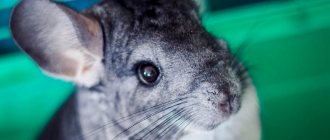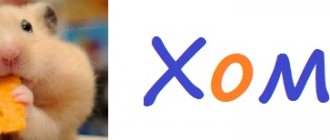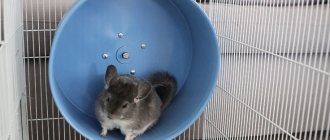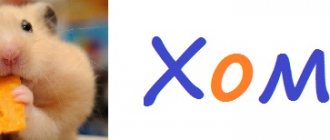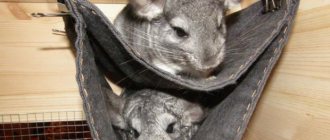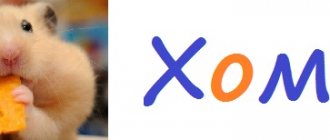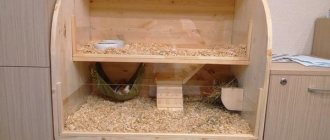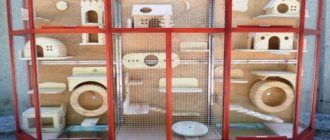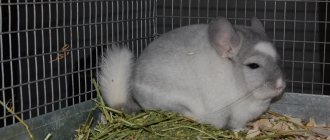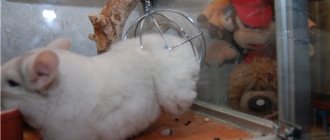Providing a chinchilla with good and proper nutrition is the most important task for its owner. If this is not done, the animal will often get sick, and you will spend a lot of time and money on its treatment. Therefore, it is better to immediately find out which food is best for your chinchilla. Nowadays there is a huge variety of food for chinchillas, so choosing is becoming increasingly difficult.
In this article we will look at what types of food there are for chinchillas and which one is best to choose, as well as a small rating of the most popular foods according to the owners of the animals. The food must contain all the necessary microelements and vitamins for the chinchilla to grow healthy.
Types of food for chinchillas
Two types of dry food are used for chinchillas:
- Regular, crumbly
- Granulated
Both are great for chinchillas, but there are significant differences. Regular food contains all the necessary vitamins and microelements, but the chinchilla will very often choose what she wants to eat. In this case, they can throw aside components that are unpleasant to her taste, which are actually very important for her health.
Granulated food, as you already understood, is granules in which all the components are compressed at once. The chinchilla will no longer be able to select individual components and will have to eat the whole food. In this case, she will definitely receive all the necessary vitamins and minerals.
As we have already understood, granulated food is slightly superior to regular food, but it is often more expensive. Therefore, you will have to decide for yourself what food to give your pet.
Nutrition for chinchillas in nature and in captivity
Chinchillas are herbivorous rodents. In nature, their diet is rather meager, consisting of cereals, various seeds, moss, bark and trees. In this case, each food component is dried with the help of wind and sun rays. In this regard, an important condition for keeping chinchillas at home is moderation in diet.
The basis of the menu for these animals at home is high-quality granulated feed, fresh hay and liquid.
In addition to these key components of the diet, the animal must also receive in the required quantities:
- Pumice.
- Mineral stone.
- Salt roller.
For chinchillas, it is of fundamental importance to use only granulated food created specifically for this type of rodent. Food intended for other animals is not suitable.
Experts recommend giving preference to granulated farm feed, which is produced directly for this type of animal. Factory-made food, especially inexpensive ones, usually includes preservatives, which guarantees the possibility of long-term storage, but makes it absolutely impossible to consume.
Therefore, when choosing factory feed, choose the one with the shortest shelf life. This granule does not contain preservatives in quantities dangerous for animals.
Pros and cons of feed
Regular food
| pros | Minuses |
| Low price | Chinchilla doesn't eat it completely |
| Available in any store | Sometimes important microelements and vitamins are missing |
| You can do it yourself |
Granulated (compound feed)
| pros | Minuses |
| Eats all the food completely | High price |
| Contains vitamin supplements | Not available in all stores |
| Prevents intestinal diseases |
As you can see, each food has its own disadvantages, but the most important thing is that regular food is cheaper and you can make it yourself if you don’t trust stores. The composition of both foods is approximately the same, but the granulated food contains more useful additives.
Meal schedule
Typically, rodents eat according to a schedule. Therefore, as the reviews say, such a schedule should be created for animals. It is better to feed chinchillas in the evening, since at this time the pet becomes more active.
You should also always monitor the presence of water in the drinking bowl. There is an opinion that chinchillas do not drink water in captivity, but this is just a myth. If chinchilla food is used, a sufficient amount of fluid must be supplied to the body.
Regardless of the diet and food used, there should always be dry grass and hay in the pet’s house. Therefore, it is recommended to make a separate feeder for him.
Composition of food for chinchillas
It is important to read the composition of the food to make sure that all the necessary components are present in it. And if some of them are missing, then it is necessary to change the food or give the missing vitamins in a different form.
Regular food usually includes:
- Barley, oats and other grains.
- Seeds
- Barley, corn or grass flour
- Bone meal, chalk and other calcium supplements
- Supplements with vitamins, lysine, etc.
The composition is quite simple and you can make this food yourself, read about it below.
Composition of granulated feed (compound feed)
Some call kibble food compound feed, but in reality it is just regular kibble food for chinchillas.
- Cereal products
- Meals
- Herbal flour
- Syrup
- Various oils, for example, vegetable
- Products with calcium, most often limestone
- Premix with vitamins and minerals
- Complex supplements containing all necessary vitamins and microelements
- Probiotics, phosphates, salts, etc.
- Supplements That Prevent Intestinal Diseases
Judging by the composition of granulated food, we see that it is much better balanced and will be an order of magnitude higher than regular food. And most importantly, it contains additives that prevent intestinal diseases, which are very dangerous for chinchillas.
Reviews of ready-made food
Each breeder is guided only by personal experience and has his own opinion. Chinchillas are very picky eaters, and if one of them likes the food, this does not mean at all that the rest of the animals will eat it. Beafar food is recognized as one of the best. Its main drawback is the price. For 250 grams of food, on average you will have to pay 375 rubles. If the number of animals is large, it turns out to be quite expensive.
Many people find Little Van granules sweetish, so it is often mixed with crushed grain and used as a top dressing. However, most owners are satisfied with Green Valley feed. Even though it is more like compressed hay: it is clean, aromatic, varied, and rodents eat it willingly.
Vitacraft and Versele Laga also have many positive reviews and supporters. But about the Zverushka granules the reviews are the most opposite. Some owners complain that Zverushka pellets are unbalanced and have a high percentage of corn.
Composition of premium food and how they differ.
To understand why you pay a lot of money when you buy premium food, you need to carefully read the composition. In this case, premium food from Fiory was used. Almost all premium food is supplied only in granules.
- The basis is taken from useful herbs: Timothy grass, medicinal dandelion, fescue, ryegrass, plantain, common gum, nettle leaves, thyme, shepherd's purse, two types of clover, meadowsweet, verbena, common fragrant spikelet, ragweed, plantain leaves, kupir, foxtail , Bermuda grass, peas, chicory, fennel.
- Quartz sand for grinding teeth
- Mineral supplements, yeast feed and yeast cell walls, chicory inulin, fructose, nucleotides, substances containing omega 3 and omega 6, beta glucan,
- As a result, we get the content of vitamins A, D3, E, B1, B2, B6, B9, B12 and several more.
- Balanced amount of fat, fiber and protein. 12% protein, only 3% fat, 43% fiber, 8% ash.
Unfortunately, this food states that it contains 0% calcium and phosphorus, which means you will have to independently add components that contain them to the diet. It turns out that premium food for chinchillas will not fully satisfy the need for useful components.
But the most important thing is that the composition is very diverse and contains many useful herbs, vitamins and microelements. The cost of such food starts from 400 rubles per pack, which weighs on average 800 grams. If a chinchilla eats 40 grams of food per day, then it turns out that 800 grams is enough for 20 calendar days, respectively, 1.5 packs of food are needed for months. This means you only need to spend 600 rubles per month for 1 chinchilla. I think this is not so much, but if you keep several chinchillas, the costs will be huge.
Jr Farm food
Jair Farm chinchilla food contains:
- dried fruits,
- vegetables,
- various herbs,
- as well as the substance inulin, which is extracted from parsnip root (chinchillas need to consume it for the proper functioning of the digestive system).
Yucca extract, which is present in the food of this brand, acts as a “flavor” for unpleasant odors from chinchilla secretions.
The presence of various herbs in the nutritional mixture (lovage, thyme, fennel, etc.) allows the animal to receive all the substances its body needs without additional complementary foods. In addition, this composition is enriched with the necessary amount of coarse fiber (for proper digestion of the animal). As well as vitamins and minerals.
Positive qualities of this nutritional mixture:
- well-balanced nutrients needed by the animal;
- decent quality products for a relatively low price.
Negative aspects of the product:
- the mixture consists of disparate components;
- Quite rarely appears on sale.
How to make food for chinchillas with your own hands
To begin with, I will write to you about the pros and cons of food that you make yourself for your chinchillas.
Pros.
- The food will definitely contain all the necessary vitamins and microelements.
- It will always be fresh, and you know exactly its composition
- If the chinchilla does not like certain components, they can be replaced with similar ones
- For each age, season and state of health of the animal, it needs to add different herbs and berries. Sometimes it is necessary to remove overly nutritious components from the diet if the chinchilla becomes obese.
- The food will be much cheaper, but in terms of beneficial properties it will be on par with elite food
There are not many disadvantages
- It is necessary to monitor the condition of the animal until it gets used to the new food.
- You need to buy different components yourself, which are not always easy to find.
What should be included in homemade food:
- It is imperative to have solid grain products so that the chinchilla has something to chew on.
- The base should consist of flour: grass, corn, wheat or barley
- A binding component, for example milk powder.
- There must be calcium, which is contained in lime, bone meal or chalk.
- Special additives. Food sulfur, leaves of nettle or berry trees.
- During cold periods or when the chinchilla is sick, it is necessary to add dry berries and herbs. For example, ground dry rosehip in small doses helps very well; it strengthens the overall immune system.
- Vitamin complexes with microelements, which are sold in any pet store. Their dosage is usually indicated on the package.
Feed preparation process
- Grind the necessary ingredients
- Mix all dry ingredients in any convenient container
- Add water by eye until all ingredients turn into a thick porridge.
- Pass through a meat grinder
- Dry in an electric dryer. You can dry it naturally, but only in very hot weather and low humidity. If mold or rot from moisture forms in the food, then in 99% of cases you will doom your pets to digestive problems.
Differences between brands of pelleted feeds
Some manufacturers, such as Vitacraft, use chopped and dried vegetables and grains as the main component, while others, like Green Valley, use grass meal. In some foods (Versele Laga) you can find more fruits and saccharides, and some (from Zverushka) contain not only basic herbs and grains, but also corn. Which food to choose depends on the preferences of the pets. Some animals prefer foods high in nuts, while others prefer grasses.
Stern Green Valley
One of the most popular foods, Little Van, contains more than 60 different plants, as well as fructooligosaccharides, which are natural probiotics. They are necessary not only for good bowel function. The acids included in the composition - Omega three and Omega six - have an excellent effect on the appearance of the animal: the fur becomes more shiny, the color is bright, and the skin becomes healthy. Green Valley Little Van granules also contain yeast extracts, additionally saturated with selenium, various vitamins, and beta-glucans.
Green Valley granules are also supplemented with natural flavoring additives: fruit pieces, dried berries and inflorescences. But the granulate does not contain any grain components, so it is most often used to feed overweight chinchillas, as well as for animals with additional grain food.
Little Van does not contain any food colors or GMOs.
Stern Versele Laga
Products under the Versele Laga brand contain:
- Herbs,
- Carrots, beets, parsnips, artichokes,
- Sweet carob, bananas, apples and rose hips,
- Beneficial extracts of grape seed, yucca, vegetable proteins and calendula,
- Flax-seed,
- Minerals,
- Yeast cultures,
- Fruit oligosaccharides.
The percentage looks like this:
- 16% - protein,
- 15% - fiber,
- 5.6% - ash,
- 3.5% - fats.
Vitacraft granulated feed
Vitacraft granulates are grain-containing. In addition to grains, the composition contains herbs, mineral components and fats. Percentage:
- Fiber: 18.4%,
- Protein: 16%,
- Fats: 2.9%,
- Ash: 10%.
One of the varieties of Vitacraft - Pellets - is designed specifically for dietary nutrition and contains malt granules. No sugar, flavorings, dyes or preservatives are used in production.
For chinchillas that are over ten years old, the company has developed Special Vitacraft, consisting of:
- Alfalfa: 25%,
- Cereals: 24%,
- Vegetables: 5%,
- Vegetable oil: 0.5%,
- Yeast cultures: 0.02%.
A separate Vitakfrat for young animals has also been developed. The difference is a high percentage of calcium, phosphorus, omega acids and plant fibers.
Animal Poop
Zverushka mixture granules consist of:
- Dried herbs: Vetch, alfalfa, dandelions, plantain, etc.,
- Milled grains: wheat, oats, corn,
- Various vegetables,
- Yeast.
The food is suitable for all age groups and as a standalone food. It does not require additional grain supplements or flavoring additives.
Stern Beafar
Beaphar Care + food belongs to the Elite class food. They are not only balanced in composition, but also have an excellent taste and smell. When extruding granules, all components are subjected to short-term, but very high pressure and temperature treatment. The result is a change in the structure of all substances while maintaining taste and nutritional qualities. Processing takes no more than 30 seconds - during this time all components are mixed, compressed, crushed, heated, sterilized and formed into granules. A sharp change in pressure leads to the complete destruction of fungi and bacteria.
In terms of its nutritional properties, Beafar is as close as possible to the food that animals eat in their natural habitat.
Beafar has low humidity, low levels of fat and sugar. However, the food is very rich in fiber, amino acids, and vitamins. Omega acids have a good effect on heart function and blood circulation, and natural probiotics normalize intestinal function. Spirulina and echinacea strengthen the immune system.
DIY food recipe, from one of the chinchilla owners
X: In my city it’s hard to find food; they only bring the cheapest food that is suitable for all rodents. I won’t say anything about its usefulness, because my chinchillas are very reluctant to eat it and have to throw away more than half of the portion.
They liked the granulated food most of all, and its composition was so varied that there was no doubt about its usefulness. There was one problem, it costs a lot of money. Even for 2 chinchillas I had to buy a decent amount; I can’t even imagine how expensive it would be to keep 4-5 chinchillas with such prices for granulated food.
After reading a bunch of literature and decided to make the food myself, but since I love my chinchillas and don’t want to risk them, I decided to show my food to several veterinarians and they advised me to remove some of the components. Along with this, I received some tips on what and when to add to chinchillas at different times of the year, and what not to add.
As a result, I ended up with this feed composition:
- Hay flour
- Medium-ground grains: oats, barley, wheat
- Wheat bran
- Ground corn
- Buckwheat
- Some flax seeds
- Peas
- Special feed shakes
- Hercules porridge
- Additive Premix P90-1
- Regular salt
- Tricalcium phosphate
- As a binding component, like everything else, I used milk powder.
The recipe is the simplest. I pre-grind the ingredients that require it in a regular coffee grinder. I leave the grains in such a form that the chinchilla has something to chew on, otherwise she will have nothing to wear off her teeth and hooks will appear. Then I just mix everything in a saucepan, add a minimum of water and put it through a meat grinder. Next, I dry it in an electric dryer and start checking it 2-3 hours after the start of drying. If you overdo it with water, it will take a very long time to dry.
I didn’t give them new food right away, I gradually got them used to it. In the first week he gave 25% of the new food, the next week 50% of the food. I constantly monitored how the chinchilla eats and saw that it eats store-bought and my granules absolutely equally, therefore, as soon as the store-bought food ran out, I immediately began to give a 100% portion of home-made food.
I wrote this recipe after 7-8 months of feeding my own food. I didn’t notice any changes in the chinchilla’s behavior. Those. no miracle happened and nothing bad either. She runs actively, boluses are of normal length, and has not yet encountered any digestive diseases.
This recipe is at your own discretion, so use caution when transitioning your chinchillas to it. If you notice any bad changes in your chinchilla’s condition, we recommend that you stop eating homemade food.
Typical mistakes when making food yourself:
- You cannot grind grains into fine flour. It is necessary to leave at least 1 ingredient in a hard form. If the chinchilla has nothing to chew on, then its teeth will not wear down and hooks will begin to form on its teeth.
- Do not add treats to the food. They must be given separately so that the chinchilla does not get used to them and does not develop intestinal problems.
- Do not use vegetables, fruits or fresh herbs. They will develop mold and rot, which will at least cause bloating in the chinchillas.
- Lack of beneficial additives and minerals. Some people think that natural food made from grains and cereals is enough for chinchillas, but this is far from the case. In nature, rodents themselves find the components they need, but in a cage this is impossible. Therefore, the availability of all the necessary vitamins and microelements rests on your shoulders.
- Instant transition to new food. The biggest mistake that leads to indigestion. Chinchillas need to be switched to a new food gradually, firstly, they have a hard time getting used to the new one, and secondly, it may not suit them. Start giving food in a ratio of 25% of the new food and 75% of their usual food, then observe the behavior of the chinchilla.
If your food contains all the necessary ingredients, then your pet will eat it with great pleasure. With proper nutrition, your chinchilla will live with you for more than 15 years.
Which food is better to choose
It is necessary to choose food for a chinchilla taking into account the individual characteristics of the rodent. To do this, you will need to carefully study the composition, and in some cases, get advice from a veterinarian. When choosing from the compositions listed above, you can use the following recommendations:
Before buying a pet, it will be useful for the future owner to read a brief overview of the most common chinchilla foods. This will help you carefully prepare for the arrival of a new family member and provide him not only with a new house, but also with tasty and healthy food.
Source

